
|
Sale 31
Pre-Long Beach Coin Auction
| Lot |
Photo |
Description |
Realized |
Lot 2096 |
 |
Great Britain. ¼ Noble, ND. S.1757; Fr-111. Henry V, 1413-1422. Arms. Reverse: Ornamental cross. Although a small coin, all Quarter Nobles are rare in high grade. With a value of one shilling and eight pence this coin found favor in general circulation, and the majority of surviving specimens are well worn. Struck around the time of the Battle of Agincourt, 1415, this is a remarkable piece. NGC graded MS-63.
Estimated Value $1,000 - 1,250.
The Cheshire Collection.
View details and enlarged photos
| Realized
$1,553 |
Lot 2097 |
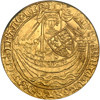 |
Great Britain. Noble, ND. S.1799; Fr-112. Henry VI, First Reign, 1422-1461. London. Annulet issue. Ruler in ship. Reverse: Ornamental cross. This London Noble is distinguished by the annulet by the sword arm of King Henry portrayed on the obverse of this magnificent coin. An excellent cameo portrait and a remarkably round coin. Lightly toned. NGC graded MS-64.
Estimated Value $3,250 - 3,750.
The Cheshire Collection.
View details and enlarged photos
| Realized
$7,188 |
Lot 2098 |
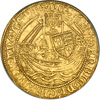 |
Great Britain. ½ Noble, ND. S.1805; Fr-113. Henry VI, First Reign, 1422-1461. London. Annulet issue. Ruler in ship. Reverse: Ornamental cross. In reality, the Half Noble is rarer in high grade than the Noble. This is an exceptionally round and well-struck example. Just a delight to study!. NGC graded MS-64.
Estimated Value $3,000 - 3,500.
The Cheshire Collection.
View details and enlarged photos
| Realized
$3,565 |
Lot 2099 |
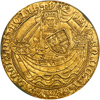 |
Great Britain. Noble, ND. S.1817; Fr-115. Henry VI, First Reign, 1422-1461. Ruler in ship. Reverse: Ornamental cross. This very rare variety of Henry VI Noble is categorized as the 'rosette-mascle issue' of 1427-1430. Struck in London, the coin has a lis by the King's sword arm and in the reverse field; stops, rosettes and mascles. The current (Spink 2005) catalogue price in Very Fine grade is £2000 (currently around $3800). There is no catalogue pricing for and XF or better specimen. NGC graded MS-63.
Estimated Value $6,500 - 8,500.
The Cheshire Collection.
View details and enlarged photos
| Realized
$6,613 |
Lot 2100 |
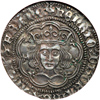 |
Great Britain. Henry VI (1422-61) silver Groat. S-1836. Annulet to each side of the king's chin. Calais mint. A common type in stunning condition. NGC grade indicates just a hint of rub on the high points. In addition, this coin sports gorgeous medieval gray toning and a bold strike with the portrait as detailed as exists, the long reverse cross almost ridged it's so bold, and most of the legends in high relief. The cataloguer has seen one or two strictly MS pieces, but none finer in eye appeal or strike than this fabulous example of its type. NGC graded AU-58.
Estimated Value $375 - 425.
The Cheshire Collection.
View details and enlarged photos
| Realized
$690 |
Lot 2101 |
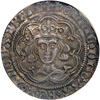 |
Great Britain. Groat, ND. S.1859. Henry VI, 1422-1461. Rosette-mascle issue. Calais mint. Toned. NGC graded EF-45.
Estimated Value $150 - 200.
View details and enlarged photos
| Realized
$242 |
Lot 2102 |
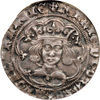 |
Great Britain. Henry VI (1422-61) silver Groat. S-1914. Leaf-pellet issue of 1445-54. Cross fleury mm (used 1435-60). Two-tone gray but mostly medium in color, clear portrait, full flan but many details not fully struck (or engraved in the dies) as can be seen from the example used in the Spink book to illustrate this style. It would be difficult to locate a nicer example of this type, than the present specimen. NGC graded EF-45.
Estimated Value $350 - 400.
The Cheshire Collection.
View details and enlarged photos
| Realized
$368 |
Lot 2103 |
 |
Great Britain. Ryal or Rose-Noble, ND. S.1951; Fr-132. Edward IV, First Reign, 1461-1470. Light coinage. Ruler in ship. Reverse: Ornamental cross. The gold noble had hardly changed in style, value or quality since the reign of Edward III and the increase in the price of gold during the 15th century resulted in a shortage of gold coins in England as they were taken to continental Europe for a profit. Eventually, during the early part of the reign of Edward IV, to stop the outflow from England, the value of all gold nobles in circulation was raised from six shillings and eight pence to eight shillings and four pence. A new coin-Rose Noble or Ryal-was introduced with a value of ten shillings. This coin was distinguished by the rose on the King's ship and a somewhat different reverse design. The London Mint Rose Nobel offered here is very high grade, with an exquisite portrait of the King. NGC graded MS-63.
Estimated Value $3,000 - 3,500.
The Cheshire Collection.
View details and enlarged photos
| Realized
$4,140 |
Lot 2104 |
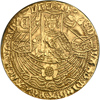 |
Great Britain. Ryal or Rose-Noble, ND. S.1952; Fr-133. Edward IV, First Reign, 1461-1470. Light coinage. Flemish imitative coinage. Ruler in ship. Reverse: Ornamental cross. As England's European trade steadily increased during the 14th and 15th centuries large quantities of English coins which were known for their quality, good weight and metal fineness ended up in Europe, despite attempts to control their movement! Gold Nobles were so popular that they were imitated and produced in the Low Countries (now Belgium and Holland), but the style was quite different. This is an example of one of these interesting pieces. Struck on a large flan, with nice detail, this is a popular and desirable coin. NGC graded EF-45.
Estimated Value $1,800 - 2,200.
The Cheshire Collection.
View details and enlarged photos
| Realized
$1,898 |
Lot 2105 |
 |
Great Britain. Angel, ND. S.2187; Fr-151. Henry VII, 1485-1509. Regular obverse design of the Archangel Michael slaying the dragon. Reverse ship holding shield, cross above, h and rose at sides. A nice full coin, well struck, with a good portrait and a pleasant light original tone. Although this is not among the rarest of the many varieties of Henry VII Angel's, the condition of this coin makes it exceptional. NGC graded MS-63.
Estimated Value $2,750 - 3,250.
The Cheshire Collection.
View details and enlarged photos
| Realized
$4,370 |
Lot 2106 |
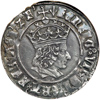 |
Great Britain. Henry VII (1485-1509) silver Groat. S-2258. Profile portrait type. Arrow or pheon mm on each side (used 1505-09). Last type of groat from the first Tudor king, a classic, and an excellent example here in the Cheshire Collection. Glossy dark gray surfaces. Excellent detail in devices and legends, with the portrait real enough to scarce you. Unlike the Spink plate coin, which is weak in this area, the top of the portrait is especially sharp on this coin, showing the large orb and cross at the top of the king's head. A beautiful example, in a word! NGC graded AU-50.
Estimated Value $800 - 1,000.
The Cheshire Collection.
View details and enlarged photos
| Realized
$1,035 |
Lot 2107 |
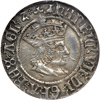 |
Great Britain. Henry VII (1485-1509) silver Half Groat. S-2261. Profile portrait type. Martlet mm (struck 1504-09, mintmark used at both Canterbury and York mints). Tudor half groats are elusive, particularly in better grade, such as this: lovely EF, two-toned medium gray, usual slight porosity in the metal, but a complete coin without cracks or damage, and a frighteningly realistic portrait of this unpleasant monarch. Seldom seen this fine, and nearly impossible to better. NGC graded EF-45.
Estimated Value $550 - 650.
The Cheshire Collection.
View details and enlarged photos
| Realized
$633 |
Lot 2108 |
 |
Great Britain. Angel, ND. S.2265; Fr-155, Henry VIII, 1509-47. First coinage. Michael slaying the dragon. Reverse: Features ship holding shield. A nice portrait and a well struck example. Gold Angels of Henry VIII are very much a continuation from the reign of Henry VII. The main difference is the obverse legend, where Henry VII Angels read HENRIC DEI GRA etc. while Henry VIII issue reads HENRIC VIII (or 8) DI GRA or DG. This is an exceptionally well struck coin which is in mint state. NGC graded MS-62.
Estimated Value $2,500 - 2,800.
The Cheshire Collection.
View details and enlarged photos
| Realized
$6,613 |
Lot 2109 |
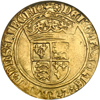 |
Great Britain. Crown of Double Rose, ND. S.2273; Fr-164. Henry VIII, 1509-1547. Crowned double rose, at sides HK (Henry and Katherine of Aragon). Reverse: Crowned arms. This short-lived denomination was introduced during Henry VIII's 1526 monetary reform. The 22 carat gold Crown proved to be the forerunner of the silver Crown first produced during the reign of Edward VI, in 1551. For some reason this denomination is generally found in low grade but this piece is a very respectable AU-55. NGC graded AU-50.
Estimated Value $1,250 - 1,500.
The Cheshire Collection.
View details and enlarged photos
| Realized
$1,265 |
Lot 2110 |
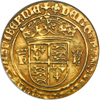 |
Great Britain. Crown of Double Rose, ND. S.2274; Fr-164. Henry VIII, 1509-1547. Mintmark, lis. Crowned double rose, at sides HK (Henry and Katherine of Aragon) on both sides. Reverse: Crowned arms. A slightly different variety of the denomination and exceptionally well struck with a pleasant old tone, this coin is worthy of a place in any collection of high grade English hammered gold coins. NGC graded MS-62.
Estimated Value $2,500 - 3,000.
The Cheshire Collection.
View details and enlarged photos
| Realized
$4,255 |
Lot 2111 |
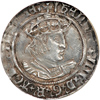 |
Great Britain. Henry VIII (1509-47) silver Groat. S-2337E. Second coinage of 1526-44. Arrow mm (used 1526-32). The classic, later portrait styled after the painting by Holbein, showing Henry in his ermine cap and jacket, but on the coin the cap becomes a crown. A very choice coin of light gray color, central details clear and appealing, legends mostly readable, uncracked flan. Rotated dies as so often seen. Slight porosity on the reverse. NGC graded EF-45.
Estimated Value $700 - 800.
The Cheshire Collection.
View details and enlarged photos
| Realized
$604 |
Lot 2112 |
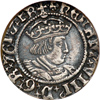 |
Great Britain. Henry VIII (1509-47) silver Half Groat. S-2343. Second coinage (1526-44). Profile portrait type. Canterbury mint. "WA" beside shield, the insignia of Archbishop Warham, of Canterbury, exercising a rare privilege to issue money, generally the sole right of the king. Two-tone gray, the portrait standing out in lighter contrast. A small scratch across the king's cloak, but otherwise an exceptionally clean and pleasing example of this classic coin. NGC graded EF-45.
Estimated Value $275 - 325.
The Cheshire Collection.
View details and enlarged photos
| Realized
$345 |
Lot 2113 |
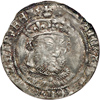 |
Great Britain. Henry VIII (1509-47) silver Groat. S-2409. Posthumous coinage of 1547-51 with three-quarters facing portrait. York mint. Light silver color with a patch of "river patina" on the reverse rim, decent portrait with sharp outlines to the beard, nose and mouth, but lacking some facial detail. Rotated dies. Fresher than most. NGC graded EF-45.
Estimated Value $650 - 750.
The Cheshire Collection.
View details and enlarged photos
| Unsold |
Lot 2114 |
 |
Great Britain. Sovereign, ND. S.2450; Fr-186. Edward VI, 1547-1553. Third period of 1550-53. Mintmark, tun. Half-length figure of king right, crowned and holding sword and orb. Reverse: Crowned shield with supporters. Well centered on a full flan and nicely struck for this issue. Free from flaws and defects. An unusually strong portrait of the boy-king. Light attractive golden-red tone. One of the finest pieces on the world market in recent years. NGC graded AU-50.
The sovereign as a denomination was introduced during the reign of Henry VII (1485-1509), and as Sutherland points out it was "deliberately so called to reflect the splendour of a great gold coin of 240 grains--twice the ryal--and worth 20 shillings"; the coin was first conceived by order of a special commission of 1489, and its engraver was Alexander of Brugsal, a German appointed in 1494 to the Royal Mint. The coin was the most elaborate ever made of gold in the British Isles, and the first tentative issues, those of both Henry VII and Henry VIII, are extremely rare. Edward VI of course was Henry VIII's son by Jane Seymour, born in 1537 and not quite ten years of age when his father passed away leaving the kingdom to him. As a child he did not rule in fact, but was influenced to make decisions by his Council and in particular by a succession of relatives--first his uncle Edward Seymour (Duke of Somerset), next by the Duke of Northumberland. Each sought to jockey his family into positions of power at court. The young king's diary tells us how he despised both of them and how he watched compromised advisors executed with cool detachment. When he died of TB at age 15, another succession of executions of royal hopefuls (including that of Northumberland's daughter-in-law, Lady Jane Gray, the king's cousin) ended in England's relapse into religious war under Mary Tudor, Henry VIII's eldest daughter, born of a Catholic mother. She rebuffed Protestant suitors and married her cousin, Philip, prince of Spain, at Winchester in 1554. He brought the idea of Inquisition to England. Nightmarish "witch hunts" of Protestants left a terrible scar on the land, but only for a short time, because Mary died of stomach cancer in 1558. Her husband had used her solely to declare war on France, which ended in disaster, the loss of Calais after two centuries of possessing it as "English territory." Upon Mary's death, Philip quickly returned to Spain, to become enemy of the new queen, Mary's younger sister Elizabeth, daughter of Anne Boleyn. Thirty years later, he would send the Armada to defeat her, but the upset battle instead ended centuries of Spain's might on the high seas, and ushered in a long era of naval glory for England. Mary Tudor's coins are all rare, her portrait on them appropriately stark, her gold sovereign a continuation of the superb line begun by her grandfather, and given true elegance during her short reign, when it was first called a "fine sovereign," reflecting an increase of its value from 20 to 30 shillings. Ironically, in later years the English sovereign was frequently coined from gold seized in warfare from Spain.
Estimated Value $14,000 - 17,000.
The Cheshire Collection.
View details and enlarged photos
| Realized
$18,975 |
Lot 2115 |
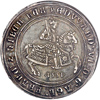 |
Great Britain. Crown, 1551. S.2478; Dav-8245. Edward VI, equestrian, facing to the right, date below. S-2478. The first dated English coin! Mintmark "Y". Fine-silver issue of 1551-53. Most examples seen of this type are dated 1553, and even they are now rare above Fine condition. But a 1551 in this condition? This is a coin almost never encountered! The great Slaney Collection had one, sharper than this but it sold in 2003 for 42,000 Pounds (about $76,000 at the time). We are not sure of the value of the present specimen, which is particularly well struck showing sharpness in the important features of the design, very little wear, none of the double-striking usually associated with this crown type, and it's also on a lovely, large, round flan. King Edward was only 14 when this coin was minted, son of Henry VIII by Jane Seymour, in fact Henry's only son. Henry's obsessive desire for a male heir of course caused the great schism between the Catholic church and himself, leading to the establishment of the Church of England. Edward's health had been fragile since birth, and the unfortunate lad died of tuberculosis in July 1553. He had no time to make a mark on his world, except perhaps numismatically, for his coins are classic works of Renaissance art, and this, his silver crown, became the very first in a long line of beautifully engraved, emblematic, large silver issues of England and later of Great Britain. This specimen is believed by the owner to be one of the finest in existence, and it's difficult to gainsay that suggestion. We are giving a wide but fairly modest estimate, considering the whopping price achieved two years ago for the Slaney specimen. This coin is not in the same league with the Slaney piece but it is nonetheless one of the best pieces to hit the market in some years. NGC graded EF-45.
Estimated Value $10,000 - 15,000.
The Cheshire Collection.
View details and enlarged photos
| Realized
$23,000 |
Lot 2116 |
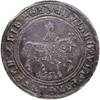 |
Great Britain. Halfcrown, 1551. Edward VI, equestrian. S-2479. Fine-silver issue of 1551-53, the last coins of this short reign and the very first dated English halfcrown. "Y" mintmark. Sharply struck in all areas of both sides, on a large flan of excellent originality, dark gray with a hint of purple. Superior flan in all respects, with the tiniest edge crack at about 6 o'clock obverse, but no scratches or marks worth noting. The details of the horseman are exceptional! All in all, a really stunning example of this important issue; most halfcrowns of this type show up in Fine or slightly better grade, but nothing like the quality of this gorgeous coin. In fact, in recent years, the only comparable specimen was in the Slaney Collection (Spink, May 2003). The Cheshire owner feels his specimen, this lot, is slightly more attractive than the Slaney piece, but whatever your individual decision might be on this topic the fact remains that the two are in the running for one of the finest known, of Britain's first dated halfcrowns, and the Slaney coin is not available to be purchased. This coin is one of those opportunities we have commented on, elsewhere in this sale, about the chance to acquire being rarer than the money needed to buy. NGC graded AU-58.
Estimated Value $12,500 - 15,000.
The Cheshire Collection.
View details and enlarged photos
| Realized
$15,000 |
Lot 2117 |
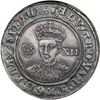 |
Great Britain. Shilling, ND. S.2482. Edward VI, 1547-1553. Fine silver issue, 1551-1553. Mintmark, Tun. Boldly struck with attractive toning. An unusually nice portrait of the 'boy King' and very rare now in this grade. NGC graded AU-50.
Estimated Value $1,500 - 1,800.
The Cheshire Collection.
View details and enlarged photos
| Realized
$1,840 |
Lot 2118 |
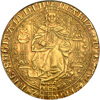 |
Great Britain. 'Fine' Sovereign of 30 Shillings, 1553. S.2488; Fr-192. Mary, 1553-1554. Mintmark, pomegranate. Queen on throne. Reverse: Arms on large Tudor rose. The daughter of King Henry VIII who reigned for a brief five years before her premature death in 1558, all Mary's gold coins are rare. This, the largest of the gold coins of the period, is unusually nice for issue. Good portrait and detail. Although the Sovereigns are often creased or mishandled, this is well centered and struck on a remarkably straight flan. A lovely, light reddish gold toning enhances this especially nice piece. A true rarity in English numismatics, and very rare so fine! NGC graded AU-58.
Now valued at 30 shillings, and of larger and finer style than preceding types, the impressive "fine gold" sovereign of Queen Mary I (1553-54, with Philip to 1558) shows the Tudor queen enthroned and holding the implements of state, a large portcullis "stop" at her feet. Reverse shows an open Tudor rose, royal shield within it. Dated in Roman numerals. Biblical inscription in Latin as reverse legend which translates as "This is the Lord's doing and it is marvelous in our eyes." An excellent example of this important rarity, made possible as a large and evenly struck gold piece of high purity by improvements at the mint which included, for the first time, crude mechanical methods for rolling metal, cutting the blanks from sheets of gold, and striking them using techniques introduced by Italian artisans. This improvement in technology may be seen here in the sharpness of the small details in the portrait, the overall clarity of impression of the dies, and the centering. Not all gold of this period claims these fine qualities, and it is evident that improvements were not consistent at the mint in the early 1550s.
Estimated Value $20,000 - 25,000.
The Cheshire Collection.
View details and enlarged photos
| Realized
$23,000 |
Lot 2119 |
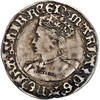 |
Great Britain. Groat, ND. S.2492. Mary, 1553-1554. Crowned head left. Reverse: Arms. Nice Fine.
Estimated Value $200 - 250.
View details and enlarged photos
| Realized
$345 |
Lot 2120 |
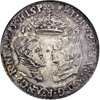 |
Great Britain. Silver Sixpence, 1554. Philip & Mary. S-2505. One of the rarest types of English coins of the 16th century. Seldom seen in any condition. A handsome coin showing some wear but also the classic failings of die-preparation and flan manufacture of its era. Light abrasions on both sides, a tiny dent in the center of the obverse, letters not fully struck up. Remnants of red wax (ancient collectors made impressions of their best coins), and also some gilding. However: the portraits are better than are usually seen, the dies are well aligned, and the overall appearance is superior to most examples, with attrractive gray toning. Very rare grade, one of the finest specimens on the market in a long time. NGC graded EF-45.
Estimated Value $1,900 - 2,200.
The Cheshire Collection.
View details and enlarged photos
| Realized
$2,185 |
Lot 2121 |
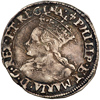 |
Great Britain. Groat, ND. S.2508. Philip and Mary, 1554-1558. Crowned bust of Mary left. Reverse: Arms. Hairline surface scratches. Toned. Fine.
Estimated Value $175 - 225.
View details and enlarged photos
| Realized
$380 |
Lot 2122 |
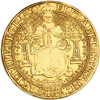 |
Great Britain. 'Fine' Sovereign, ND. S.2529; Fr-209. Elizabeth I, 1558-1603. Fifth issue, 1583-1600. Mintmark, Escallop (1584-86). Queen seated on throne. Reverse: Square shield on large Tudor rose. This is truely a superbly struck example. Elizabeth's face is fully struck and the overall coin perfectly center. A hint of luster adds to the overall visually stunning appearance. Extremely Rare this nice. Choice Extremely Fine.
Estimated Value $17,500 - 22,500.
View details and enlarged photos
| Realized
$25,300 |
Lot 2123 |
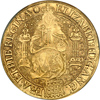 |
Great Britain. Sovereign of 30 Shillings, ND. S.2529; Fr-209. Elizabeth I, 1558-1603. 30 shillings value. Facing portrait of the queen with full insignia of state, crowned, against a "diapered" background, suggestive of the purple drapery associated with royalty since the Empire of Rome. Fifth Issue of 1583-1600. Escallop and escallop over "A" mintmarks (the escallop used 1584-86, the "A" used 1582-84, making it a reasonable estimate that this coin was struck in or within months of 1584). Reverse:A gigantic Tudor rose, in full bloom, holding in its center the royal shield. Legend on reverse copies that used on Mary's sovereign. This handsome piece was produced during the fifth issue (1582-1586) of the Queen's coinage, and a little before the appearance of the Spanish Armada in 1588. The consignor's research suggests that possibly only 6 examples are known of this combination of mintmarks, all struck from rusted dies. In fact the mintage was fairly large for all the gold denominations of this reign, which Sutherland points out was one of the benefits to England of "increased supplies in Europe of gold and silver originating from American sources," as well as from specie seized from the treasure ships of England's arch enemy during this reign, Spain. The wealth of the nation became abundant while Elizabeth was queen; the coinage became de facto the first modern coinage, of types that continued as denominations for many years to come; and England started to take on the skin of empire in these years, thanks in part to the genius of her queen. But Elizabeth's gold is not plentiful anymore, and some of it quite rare, especially in high grade, because of the vicissitudes of history over the coming centuries. Most surviving fine sovereigns cannot approach this specimen in quality. A lovely coin! NGC graded MS-62.
Estimated Value $17,500 - 22,500.
The Cheshire Collection.
View details and enlarged photos
| Realized
$18,400 |
Lot 2124 |
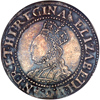 |
Great Britain. Elizabeth I (1558-1603) silver Shilling (1560-61. S-2555. Second issue, of sterling fineness, struck 1560-61. Marlet mm. Bust 3C. Elizabethan portrait coins are in furious demand worldwide. The reasons? Classic Renaissance-era styling, varying and sometimes frighteningly lifelike portraits of England's most brilliant queen, and the popularity of Elizabeth herself as a royal subject. Fewer and fewer nice portrait coins are seen on the market each year, as they are soaked up into collections. This example is especially pleasing: obvious wear and some surface abuse from the distant past, but overall it has especially good eye-appeal and is well struck. The flan is large and nearly fully round, without cracks. The portrait shows much detail and is well balanced, without weak areas. Ditto the shield and all legends, which are unusually clear. The metal's slight porosity is totally forgiven by the handsome grayish gold color of the ancient tone. All in all, a sharp coin from the beginning of Elizabeth's fascinating and long reign. NGC graded VF-35.
Estimated Value $950 - 1,100.
The Cheshire Collection.
View details and enlarged photos
| Realized
$719 |
Lot 2125 |
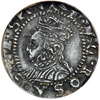 |
Great Britain. Elizabeth I (1558-1603) silver Penny. S-2558. Second issue, struck 1560-61, of sterling fineness (.925). Generally, the smaller silver of this reign is rarer than the larger, and a penny of this quality is more difficult to locate than, say, a gold Half Pound. Nonetheless the value is modest, presenting the collector with an excellent coin, in this specimen, for a decent price. An unusually pleasing EF, dark gray to black. The quality of the portrait is exceptional, and the shield is similarly sharp. Fields are really clean. Inner beaded circles are crisp. Legends not complete but far more in evidence than is the norm. An excellent coin, rare in this grade! NGC graded EF-40.
Estimated Value $150 - 200.
The Cheshire Collection.
View details and enlarged photos
| Realized
$242 |
Lot 2126 |
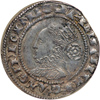 |
Great Britain. Elizabeth I (1558-1603) silver Threepence, 1575. S-2566. Eglantine mm (used 1573-78). Third coinage, sterling fineness. Lovely light gray surfaces, splendid portrait with slight doubling of strike on the queen's nose and chin but far, far finer in detail than is seen on most silver coins of any denomination. An excellent coin! NGC graded AU-50.
Estimated Value $250 - 300.
The Cheshire Collection.
View details and enlarged photos
| Realized
$322 |
Lot 2127 |
 |
Great Britain. Elizabeth I (1558-1603) silver Half Groat. S-2579. Two pellets behind the queen's portrait. Fifth issue of 1582-1600, of sterling fineness (.925). Seashell or escallop mm (used 1584-86). Classic late-period portrait in low relief. Light gray. Overall the details are clear and the flan is more complete than usually seen. NGC graded EF-45.
Estimated Value $150 - 200.
The Cheshire Collection.
View details and enlarged photos
| Realized
$138 |
Lot 2128 |
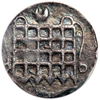 |
Great Britain. Silver Portcullis Halfpenny (1582-1600). Elizabeth I (1558-1603). S-2581. Fifth issue of 1582-1600, made of sterling fineness (.925). Reverse features a long, Moline cross (with incurving end hooks) with connected triple pellets filling two quadrants and single pellets filling the other two. While catalogued by Spink separate from the Trade Coinage showing a portcullis, this clearly is part of that issuance for its stylistic link, and is an important example of an early coin meant for use abroad. Insightfully graded by NGC, this is indeed a delightful example, clear of problems and having a good flan, or planchet. The metal looks sound. See the Spink book for the distinctive shape, which this coin possesses. Medium gray color with sharp details. Lovely and rare in this grade! NGC graded AU-55.
Estimated Value $150 - 200.
The Cheshire Collection.
View details and enlarged photos
| Realized
$184 |
Lot 2129 |
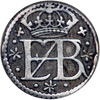 |
Great Britain. Silver Pledge Halfpenny, 1601. Elizabeth I (1558-1603). Not listed in Spink. Peck-6 (called "very rare"). Crowned royal monogram on obverse includes each of the letters of "ELIZABETH R." Portcullis with date above on reverse. Stops in the devices reminiscent of those used on Anglo-Saxon pennies, which seemingly function primarily to balance the design. This monarch was known firstly for her brilliance as an administrator and a negotiator, not merely for keeping her head during some six decades of the most treacherous political times in England's history, but also for leading her country through foreign war and global exploration. It was said that Elizabeth, daughter of Henry VIII and Anne Boleyn, could listen to entreaties at court by the Portugese ambassador while dictating a letter in French and signing legal papers in Latin and listening to singing in Italian, all at the same time! She was born in 1533, and during her youth her irascible father spent much time robbing ancient abbeys of their lead windows for war materiel and spending the nation's treasury at a furious pace on his pleasures. At his death his currency had been seriously demeaned of intrinsic value; his son and first daughter ruled after him, albeit shortly and disastrously, and neither did anything to revive the currency or the public's faith in it. By contrast, Elizabeth took great interest in resuscitating the national money and treasury, and in only a short while she had restored gold and silver coinages to high standards of value. Under her reign, a wide variety of denominations was created and minted, including the famed Portcullis Money for foreign trade and some of the first true patterns in English numismatic history. This wonderful little coin is one of them! A quarter-century before it was made, a proposal was set forth to produce a copper coinage, but copper had never had royal sanction, only specie (gold and silver). The idea was put to the queen to issue "pledges" of value, made of copper but backed in exchange by The Crown in quantity by silver. The concept was never promulgated, never got to the minting stage, other than in the form of a few very rare patterns. Some are known in silver, and some in copper with a silver "wash" or light coating. These have long suffered from a dubious origin, being suspect by both Montagu and Peck, but Stephen Martin Leake mentions them in his Historical Account of English Money, published in 1793 (see page 259), and today's collectors avidly seek any of these pledge issues as part of Elizabeth's numismatic heritage. This delightful specimen is NGC graded only VF30, but the cataloguer is quite taken by its sharpness of detail and its unusually fine eye-appeal. Two-toned gray with the design bold. No flaws, no damage. An important coin! Believed by the consignor to be second finest known of the four pieces in private hands. NGC graded VF-30.
Estimated Value $3,250 - 3,500.
The Cheshire Collection.
View details and enlarged photos
| Unsold |
Lot 2130 |
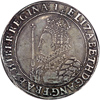 |
Great Britain. Halfcrown, 1601. S.2583. Elizabeth I. Mintmark, 1. Crowned bust holding sword and orb left. Reverse: Arms on quartered field. A lovely, balanced coin for the grade, having excellent medium gray toning. No flan cracks as so often seen, even on the best of these. Also, the flan is almost perfectly round, the legends are totally clear and readable, the shield and portrait of the queen unusually well detailed. A classic of its age, always in keen demand from historically curious collectors. NGC graded VF-30.
Estimated Value $4,000 - 5,000.
The Cheshire Collection.
View details and enlarged photos
| Realized
$3,840 |
Lot 2131 |
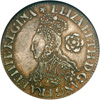 |
Great Britain. Sixpence, 1562. S.2594. Elizabeth I. Milled coinage. Mintmark, star. Narrow bust with large rose to right. NGC graded EF-40.
Estimated Value $800 - 1,000.
The Cheshire Collection.
View details and enlarged photos
| Realized
$690 |
Lot 2132 |
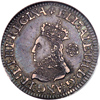 |
Great Britain. Silver Milled Sixpence, 1567. Elizabeth. S-2599. Small, later bust. Lis mm on each side. Beginning in 1561 a new method was experimented with at the Royal Mint, an ancient building inside the outer walls of the Tower of London (today, no indication of this building exists). Eloye Mestrelle was imported from France; his use of a screw press powered by horse-drawn "mill" produced uncommonly handsome and regular coins, of which this beautiful sixpence is a prime example. The new money took its name from the mill used to power the press, and today has evolved into "Milled." Unfortunately, being French, Mestrelle fell out of favor at the Mint, which accused him of taking too long to make his money. He was dismissed in 1572, and disgruntled turned to counterfeiting, or was so accused and convicted, and hung for crimes against the Crown. His legacy, however, lives on in the triumph of coins which made their contemporaries look poor indeed. This is a lovely example. The planchet is slightly wavy, as is normal. The surfaces are a well-set medium gray. The details are all sharp. The surfaces show small abrasions but are, far and away, finer than almost always seen. NGC graded EF-45.
Estimated Value $1,100 - 1,300.
The Cheshire Collection.
View details and enlarged photos
| Realized
$870 |
Lot 2133 |
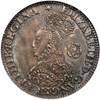 |
Great Britain. Elizabeth I (1558-1603) Milled silver Threepence, 1562. S-2603. N-2034. An exceptionally fine example, with lovely lightly iridescent gray surfaces, virtually no marks, deeply detailed portrait as found mainly on this issue, Tudor rose behind the queen, star above her head and at start of reverse legend. Error "I" for "T" in her name. Distinctive mid-16th-century lettering style. The Brits will call this "Good EF," and in fact it's nearly as good as it gets! Very rare grade. NGC graded MS-63.
Estimated Value $1,500 - 2,000.
The Cheshire Collection.
View details and enlarged photos
| Realized
$1,560 |
Lot 2134 |
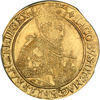 |
Great Britain. Unite, ND. S.2618; Fr-234. James I, 1603-1625. Second coinage (1604-19). Second bust. Mintmark, lis. Half length figure of King facing right, holding orb and shouldering sceptre. Reverse: Crowned shield of arms, I R at sides. Legend FACIAM. Struck on a large round flan. This is one of the rarer types of James I Unite, very seldom seen in this condition. NGC graded MS-62.
Estimated Value $3,500 - 4,500.
The Cheshire Collection.
View details and enlarged photos
| Realized
$6,038 |
Lot 2135 |
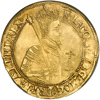 |
Great Britain. Unite, ND. S.2619; Fr-234. James I, 1603-1625. Second coinage (1604-19). Fourth bust. Mintmark, Tower. Crowned half-length bust right. Reverse: Crowned arms. One of the more common of the Jacobean gold coins this Unite is nevertheless remarkable for its high grade. Now practically unobtainable in mint state this MS 63 coin has original luster and a sharply detailed portrait of the King who united the thrones of England and Scotland. NGC graded MS-63.
Estimated Value $3,000 - 3,500.
The Cheshire Collection.
View details and enlarged photos
| Realized
$3,795 |
Lot 2136 |
 |
Great Britain. Unite, ND. S.2619; Fr-234. James I, 1603-1625. Second coinage (1604-19). Fourth bust. Mintmark, Trefoil. Crowned half-length bust right. Reverse: Crowned arms. Another mint state example of this variety of James I Unite, but it has a different mint mark (trefoil). The half length figure of the King is exceptionally well struck for what was often a crudely produced coin. Very original and with no apparent wear. NGC graded MS-61.
Estimated Value $2,250 - 2,750.
The Cheshire Collection.
View details and enlarged photos
| Realized
$1,668 |
Lot 2137 |
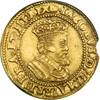 |
Great Britain. Crown, ND. S.2626; Fr-236. James I, 1603-1625. Second coinage. Mintmark, Tun. Crowned bust right. Reverse: Crowned square shield. A virtually mint state example of a popular denomination which saw a lot of use as a circulating coin. Tough to find in this high grade. NGC graded AU-58.
Estimated Value $1,250 - 1,500.
The Cheshire Collection.
View details and enlarged photos
| Realized
$1,265 |
Lot 2138 |
 |
Great Britain. Thistle crown or 4 Shillings, ND. S.2627; Fr-238. James I. Second coinage. Mintmark, lis (struck 1604-05). Crowned rose, "I R" at sides. Minor scrape beneath the R. Reverse: Crowned thistle. The Thistle Crown is normally a poorly struck coin, whereas this marvelous specimen is so bold that all the cross-hatches of the thistle may be discerned. Extremely rare this nice, and unusually pleasing! In fact, the finest we have seen. NGC graded MS-62.
Estimated Value $2,500 - 3,000.
The Cheshire Collection.
View details and enlarged photos
| Realized
$3,220 |
Lot 2139 |
 |
Great Britain. Rose-ryal (30 Shillings), ND. S.2632; Fr-239. James I, 1603-25. Third coinage (1619-25). Mintmark, thistle. Crowned figure of King enthroned, facing, holding orb and sceptre, portcullis at feet, dividing the legend as his crown divides it at top. In the field, an intricate pattern of roses and lis insignia, known in art as "diapering." Reverse: Within a Biblical legend in Latin, a long cross over the shield of arms with the mark of value above. Inside the circular legend and surrounding the shield, a band decorated by images of lis, lions and roses. The Latin legend again translates as "This is the Lord's doing and it is marvelous in our eyes." One of the rarities of this reign, this specimen is particularly fine, exceptionally crisp in strike on a full flan, essentially "as struck." In fact it is the very symbol of its age! Truly one of the finest examples of this large and very rare ornate coin ever seen. NGC graded MS-65.
Estimated Value $20,000 - 25,000.
The Cheshire Collection.
View details and enlarged photos
| Realized
$41,400 |
Lot 2140 |
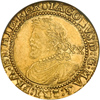 |
Great Britain. Laurel (20 Shillings), ND. S.2638A; Fr-242. James I. Third coinage (1619-25). Mintmark, thistle. Laureate armored bust left, value behind. Reverse: Long cross over square shield. A popular denomination - the new lighter 20 shilling coin which temporarily replaced the gold Unite. This has a strong portrait and is well struck if not uncirculated. It is also a rarer variety of Laurel. NGC graded AU-55.
Estimated Value $2,000 - 2,500.
The Cheshire Collection.
View details and enlarged photos
| Realized
$1,725 |
Lot 2141 |
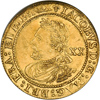 |
Great Britain. Laurel (20 Shillings), ND. S.2638B; Fr--242. James I. Third coinage (1619-25). Mintmark, trefoil. Laureate armored bust left, value behind. Reverse: Long cross over square shield. Nearly uncirculated, this is a different variety of the denomination. It is well struck overall and difficult to better. NGC graded AU-58.
Estimated Value $2,500 - 2,800.
The Cheshire Collection.
View details and enlarged photos
| Realized
$2,415 |
Lot 2142 |
 |
Great Britain. Laurel (20 Shillings), ND. S.2638C; Fr--242. James I. Third coinage (1619-25). Mintmark, lis. Laureate armored bust left, value behind. Reverse: Long cross over square shield. A well struck coin, unusually well centered. So unusually sharply struck is the portrait that one could conclude that the coin is a piece of finer workmanship or a 'presentation piece'. An irreplaceable rarity. NGC graded MS-63.
Estimated Value $3,500 - 4,500.
The Cheshire Collection.
View details and enlarged photos
| Realized
$4,140 |
Lot 2143 |
 |
Great Britain. Half Laurel, ND. S.2640; Fr-243. James I. Third coinage (1619-25). First bust. Mintmark, Spur rowel. Laureate armored bust left, value behind. Reverse: Long cross over square shield. A crisp portrait that would be almost impossible to find a more attractive example of this rare type of Half Laurel. The early half laurels were badly struck coins but this is a MS 61 example. NGC graded MS-61.
Estimated Value $3,000 - 3,500.
The Cheshire Collection.
View details and enlarged photos
| Realized
$2,645 |
Lot 2144 |
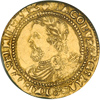 |
Great Britain. Half Laurel, ND. S.2641A; Fr-243. James I. Third coinage (1619-25). Mintmark, trefoil. Laureate armored bust left, value behind. Reverse: Long cross over square shield. Well struck and well centered. In this grade the half laurel is much rarer than the laurel. NGC graded MS-62.
Estimated Value $2,500 - 3,000.
The Cheshire Collection.
View details and enlarged photos
| Realized
$2,760 |
Lot 2145 |
 |
Great Britain. Silver Sixpence, 1603. James I. S-2647. First issue of 1603-04. First bust. Thistle mm on each side. An extraordinary example of this early coinage, seldom found so nice. Boldly struck on a broad flan with a sharply detailed portrait! Lovely medium "Renaissance gray" toning showing luster beneath. Slight blundering and some doubling of the letters of the king's name in the obverse legend, but the remainder of both legends is bright and clear, as is the shield, which shows only a touch of weakness of strike on the harp. The flan is also nearly round, which is most exceptional. The Cheshire collector comments that he feels this coin has all the hallmarks of a specimen or presentation strike (especially as it was minted during the first year of James's reign), and notes that it was once part of one of the finest collections of British hammered coins formed in the early part of the 20th century. NGC graded AU-58.
Estimated Value $1,650 - 1,850.
The Cheshire Collection.
View details and enlarged photos
| Realized
$1,898 |
|
|